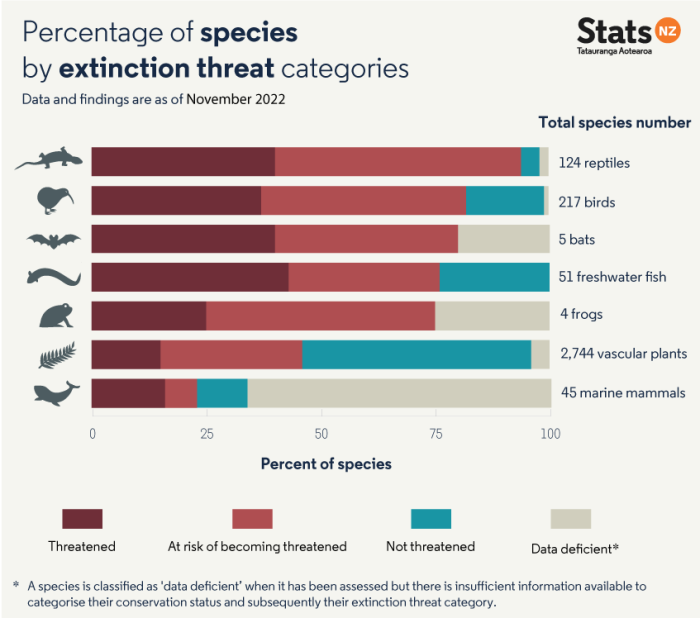More than 75 percent of indigenous reptile, bird, bat, and freshwater fish species groups are threatened with extinction or are at risk of becoming threatened, according to figures released today by Stats NZ.
"Loss of many of our indigenous species is a real possibility," environmental and agricultural statistics senior manager Michele Lloyd said.
"Ninety-four percent of our reptile species, 82 percent of bird species, 80 percent of bat species, 76 percent of freshwater fish species, and 46 percent of vascular plant species are either facing extinction or are at risk of being threatened with extinction."

Text alternative for Percentage of species by extinction threat categories
The indicator Extinction threat to indigenous species reports on the extinction threat (an assessment of extinction risk) for groupings of indigenous, resident, and living species in Aotearoa New Zealand, as assessed by expert panels under the New Zealand Threat Classification System (NZTCS). Data and findings are as of November 2022 and do not capture the impacts of the recent weather events.
It also shows that 39 of 47 freshwater and marine taonga species are threatened with extinction, or at risk of becoming threatened.
There are limitations to the use of the NZTCS. Not all species within a species group are known or have been described. Even when it has been assessed there may be insufficient information available to categorise its extinction threat.
The indicator combines three previously published webpages (Extinction threat to marine indigenous species, Extinction threat to land indigenous species, and Extinction threat to freshwater indigenous species) to provide people with a cohesive view of all assessed indigenous species.
Stats NZ publishes and updates environmental indicators on the pressures, state, and impacts of New Zealand's environment including air, marine, fresh water, land, and atmosphere and climate, as part of a joint Environmental Reporting programme with partner Ministry for the Environment (MfE).
Extinction threat to indigenous species provides more information, including estimated population trends, visualisations, and data.
Text alternative for Percentage of species by extinction threat categories
This image shows data in a stacked bar graph that presents the percentage of species by extinction threat categories for reptile, bird, bat, freshwater fish, frog, vascular plant, and marine mammal species. The extinction threat categories are threatened, at risk of becoming threatened, not threatened, and data deficient. The graph shows 94 percent of reptile species, 82 percent of bird species, 80 percent of bat species, 76 percent of freshwater fish species, 75 percent of frog species, 46 percent of vascular plant species, and 22 percent of marine mammal species are threatened or are at risk of becoming threatened. The graph shows 4 percent of reptile species, 17 percent of bird species, 0 percent of bat species, 24 percent of freshwater fish species, 0 percent of frog species, 50 percent of vascular plant species, and 11 percent of marine mammal species are not threatened. The graph shows 2 percent of reptile species, 1 percent of bird species, 20 percent of bat species, 0 percent of freshwater fish species, 25 percent of frog species, 4 percent of vascular plant species, and 67 percent of marine mammal species are data deficient. A species is classified as 'data deficient' when it has been assessed but there is insufficient information available to categorise their conservation status and subsequently their extinction threat category.






